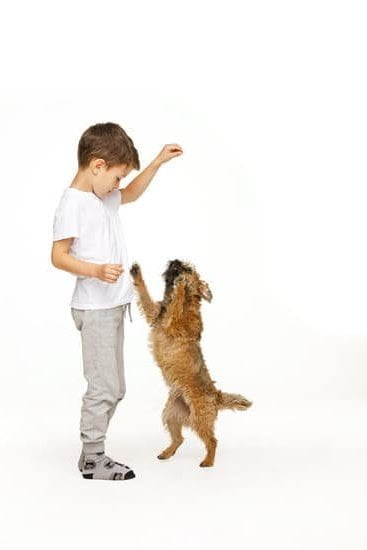Potty training a dog that has been abused can be a challenging and delicate process. Understanding the effects of abuse on a dog’s behavior is crucial in approaching this task with empathy and patience.
Abuse can have lasting psychological effects on a dog, leading to fear, anxiety, and even aggression. In this article, we will explore how to potty train a dog that has been abused, focusing on building trust, creating a safe environment, and using positive reinforcement techniques to encourage good potty habits.
Building trust and creating a safe environment for an abused dog are essential first steps in the potty training process. Dogs who have experienced abuse may be wary of new people, places, and routines. It is important to establish a secure and predictable environment for the dog to feel safe enough to learn new behaviors. Additionally, introducing crate training can provide the dog with a sense of security and help in establishing a regular routine for potty breaks.
Establishing a regular feeding and potty schedule is also vital in potty training an abused dog. Consistency in feeding times will lead to more predictable elimination times, making it easier to anticipate when the dog needs to go outside.
Using positive reinforcement techniques such as praise, treats, or playtime can be effective in encouraging good potty habits while rebuilding the dog’s confidence. Understanding the unique challenges associated with potty training an abused dog is crucial for success in this process.
Building Trust and Creating a Safe Environment for the Dog
One of the first steps in potty training a dog that has been abused is to build a trusting relationship with the animal. Many abused dogs may have trust issues and anxiety, making it difficult for them to feel safe and secure in their environment. It’s important to approach the dog with patience and understanding, allowing them to come out of their shell at their own pace.
Creating a safe environment for an abused dog is crucial in the potty training process. This can involve providing a designated safe space for the dog, such as a comfortable bed or crate, where they can retreat when feeling anxious or overwhelmed. Additionally, it’s important to ensure that the dog feels safe during potty breaks by choosing a quiet and secure outdoor area for them to do their business.
Consistency and routine are essential in building trust with an abused dog. By establishing a daily schedule for feeding, potty breaks, and exercise, the dog will start to feel more secure in their environment and understand what is expected of them. Creating a predictable routine can help reduce anxiety and fear in abused dogs, making it easier for them to learn good potty habits.
Introducing Crate Training as a Tool for Potty Training
When it comes to potty training a dog that has been abused, crate training can be a valuable tool in the process. The use of a crate provides a safe and secure space for the dog, which is especially important for an abused animal that may have trust issues or anxiety. Here are some tips for introducing crate training as part of the potty training process:
- Choose the right size crate: When selecting a crate for your abused dog, it’s important to choose one that is just big enough for them to stand up, turn around, and lie down comfortably. A larger crate may allow them to have accidents inside without feeling the need to keep their sleeping area clean.
- Gradual introduction: Introduce the crate slowly and positively to your dog. Place comfortable bedding inside along with their favorite toys or treats. Encourage them to explore the crate on their own terms without forcing them inside.
- Use positive reinforcement: Once your dog is comfortable with the crate, start feeding them their meals inside it with the door open. This will help them associate the crate with positive experiences and create a sense of security.
By implementing these steps, you can help your abused dog feel more at ease with crate training and establish it as an effective tool in their potty training journey. With patience and consistency, you can build trust with your dog and create a safe environment for them to learn good potty habits.
Establishing a Regular Feeding and Potty Schedule
The Importance of Routine
Abused dogs may have never been given the opportunity to establish a routine, leading to confusion and fear. By adhering to a regular feeding schedule, you can help your dog understand when they will have the opportunity to eat and when they should go outside for potty breaks. Consistency is key in building trust and reducing anxiety in abused dogs.
Tips for Establishing a Schedule
When establishing a feeding and potty schedule, it’s essential to be mindful of your dog’s specific needs. Start by offering meals at the same times each day, and then take your dog outside immediately afterward. Be patient as your dog adjusts to this routine, as it may take time for them to become accustomed to the schedule.
Being Patient and Consistent
It’s important to remember that potty training an abused dog will require patience and consistency. There may be setbacks along the way, but it’s essential not to get discouraged. By maintaining a regular schedule and providing positive reinforcement, you can help your dog develop good potty habits over time.
Using Positive Reinforcement Techniques to Encourage Good Potty Habits
When potty training a dog that has been abused, positive reinforcement techniques play a crucial role in encouraging good potty habits. Due to their traumatic past, abused dogs may be more fearful and anxious, making it important to use gentle and encouraging methods for training.
Here are some positive reinforcement techniques that can be used when potty training an abused dog:
– **Clicker Training**: Using a clicker to mark the desired behavior, such as eliminating in the designated area, can help reinforce the action and create a positive association for the dog.
– **Treat Rewards**: Offering small treats as a reward when the dog eliminates in the appropriate spot can motivate them to repeat the behavior. It’s essential to use high-value treats that the dog finds particularly enticing.
– **Verbal Praise**: Showering the dog with verbal praise, such as “good boy” or “good girl,” when they potty in the correct location can boost their confidence and encourage them to continue doing so.
By consistently using these positive reinforcement techniques, an abused dog can learn to trust their owner and feel secure in their environment while establishing good potty habits. It’s important to be patient and persistent, as it may take time for an abused dog to understand and respond to these training methods.
Dealing With Accidents and Setbacks in the Training Process
One approach to addressing accidents is to avoid punishment and instead focus on reinforcing positive behaviors. When accidents occur, it is important to clean up the mess without making a big deal out of it, as this can help prevent the dog from associating their accident with negative attention.
Additionally, it may be necessary to revisit some of the earlier steps in the training process, such as building trust and creating a safe environment for the dog. Providing reassurance and stability for the dog can help them feel more secure and ultimately reduce accidents. It’s also crucial to remain consistent with the training methods, even in light of setbacks, as this will reinforce good potty habits in the long run.
| Approach | Recommendation |
|---|---|
| Avoid Punishment | Avoid punishing the dog for accidents as it can further traumatize them. |
| Provide Reassurance | Give reassurance and stability to the dog through trust-building exercises. |
| Consistency | Remain consistent with training methods despite setbacks for long-term success. |
The Importance of Patience and Consistency in Potty Training an Abused Dog
Potty training a dog that has been abused can be a challenging and delicate process. One of the most important aspects of this training is the need for patience and consistency.
Dogs that have experienced abuse may have developed fear, anxiety, or other behavioral issues that can make it more difficult for them to learn new routines, including potty training. It is crucial for pet owners to understand the impact of their past experiences on the dog’s behavior and to approach the training process with empathy and understanding.
Patience is key when potty training an abused dog because they may take longer to trust their owners and adjust to a new environment. It is essential for pet owners not to rush or push the dog during the training process. Positive reinforcement techniques, such as giving treats and praise when the dog exhibits good potty behavior, can help build trust and confidence in the dog.
Consistency in the training routine is also vital, as dogs thrive on predictability and structure. Establishing a regular feeding and potty schedule can help the dog feel more secure and understand when it is time to go outside.
In addition, consistency in using crate training as a tool for potty training can also aid in creating a safe environment for the dog. The crate serves as a den-like space where the dog can feel secure and learn to control their bladder and bowel movements.
Consistently using positive reinforcement techniques while using the crate can help create positive associations with potty behavior for the dog. Overall, patience and consistency are crucial in gaining an abused dog’s trust and helping them learn good potty habits in a loving and supportive environment.
Seeking Professional Help and Guidance From a Veterinarian or Animal Behaviorist
In conclusion, potty training a dog that has been abused requires patience, understanding, and consistent effort. It’s important to recognize the effects of abuse on a dog’s behavior and take the necessary steps to build trust and create a safe environment for the dog. Introducing crate training as a tool for potty training can be beneficial, as well as establishing a regular feeding and potty schedule.
Using positive reinforcement techniques to encourage good potty habits is essential in the training process, while also being prepared to deal with accidents and setbacks along the way. Above all, patience and consistency are key to successfully potty train an abused dog. Seeking professional help and guidance from a veterinarian or animal behaviorist can also provide valuable support and expertise in addressing any specific challenges that may arise during the training process.
Remember that every dog is unique, and it may take time for an abused dog to feel comfortable and confident in their new environment. With dedication, love, and support from knowledgeable professionals, it is possible to successfully potty train a dog that has been abused.
Frequently Asked Questions
How Do You Housebreak an Abused Dog?
Housebreaking an abused dog requires patience, consistency, and a gentle approach. It’s important to establish a routine for feeding and bathroom breaks, praising the dog whenever they go outside, and cleaning up accidents without scolding the dog. Building trust through positive reinforcement is crucial in helping the dog feel safe and secure in their new environment.
How Do You Train a Dog That Has Been Abused?
Training a dog that has been abused should begin with building trust and establishing a positive relationship. Using force or punishment can trigger fear or aggression in an abused dog, so it’s essential to focus on positive reinforcement techniques such as clicker training and rewarding good behavior with treats or praise.
It’s also important to be patient and understanding of the dog’s past trauma while working on obedience training.
How Long Does It Take to Train an Abused Dog?
The time it takes to train an abused dog can vary depending on the severity of their past experiences and their individual temperament. Some abused dogs may take weeks or months to become comfortable with basic training, while others may require more time and patience.
Consistent training, along with love and understanding, can help an abused dog overcome their past trauma and learn to trust again.

Welcome to the blog! I am a professional dog trainer and have been working with dogs for many years. In this blog, I will be discussing various topics related to dog training, including tips, tricks, and advice. I hope you find this information helpful and informative. Thanks for reading!





